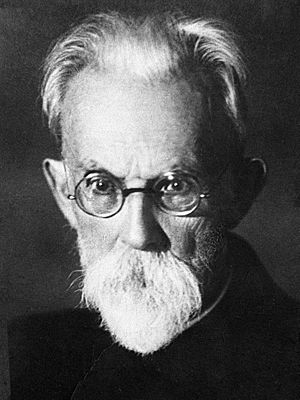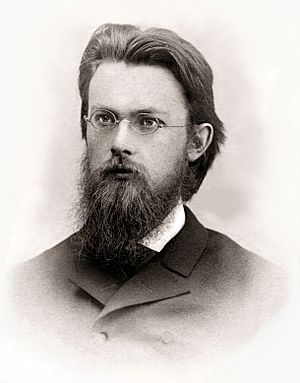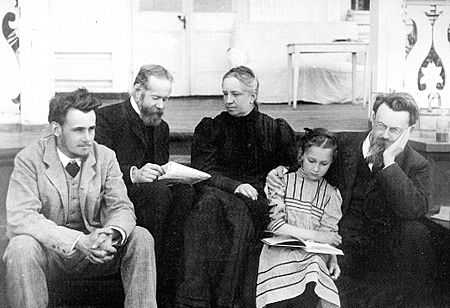Vladimir Vernadsky facts for kids
Quick facts for kids
Vladimir Vernadsky
|
|
|---|---|
 |
|
| Born |
Vladimir Ivanovich Vernadsky
12 March [O.S. 28 February] 1863 |
| Died | 6 January 1945 (aged 81) |
| Education | Doctor of Science (1897) |
| Alma mater | Saint Petersburg Imperial University |
| Known for | Noosphere Biogeochemistry |
| Scientific career | |
| Fields | Geology, crystallography, mineralogy, geochemistry, radiogeology, biology, biogeochemistry, philosophy |
| Institutions | Template:Moscow University Professor National Academy of Science of Ukraine Tavrida National V.I. Vernadsky University Moscow Institute of Fine Chemical Technologies |
| Thesis | Slip phenomena of crystalline matter |
| Influences | Vasily Dokuchaev, Andreas Artsruni |
| Influenced | Alexander Fersman |
| Signature | |
Vladimir Ivanovich Vernadsky (Russian: Влади́мир Ива́нович Верна́дский; Ukrainian: Володи́мир Іва́нович Верна́дський; 12 March [O.S. 28 February] 1863 – 6 January 1945) was a famous scientist from Russia, Ukraine, and the Soviet Union. He was a mineralogist (someone who studies minerals) and a geochemist (someone who studies the chemistry of Earth).
He is known as one of the people who started the fields of geochemistry, biogeochemistry (the study of how living things affect Earth's chemistry), and radiogeology (the study of radioactive elements in rocks). He also helped create the Ukrainian Academy of Sciences.
In 1926, he wrote an important book called The Biosphere. In this book, he explained his idea that life itself is a powerful force that shapes our planet. In 1943, he received the State Stalin Prize, a major award in the Soviet Union.
Contents
Biography
Vladimir Vernadsky was born in Saint Petersburg, Russian Empire, on March 12, 1863. His father, Ivan Vernadsky, was an economist, and his mother, Hanna Konstantynovych, was a music teacher. His family had roots in Kiev, Ukraine.
He finished his studies at Saint Petersburg State University in 1885. He decided to focus on Mineralogy because there was an open position at the university.
To prepare for his advanced degree, he traveled to Europe. He studied crystallography (the study of crystals) in Germany with a scientist named Paul Groth. Vernadsky learned how to use new equipment to study the properties of crystals, like how they react to light, heat, and electricity.
Vernadsky was also interested in politics and society. He joined a liberal political group and served in the parliament for a short time. He also worked as a professor and later as a vice-rector at Moscow University. He resigned from his university position in 1911 to protest government policies. After the 1917 revolution, he worked on commissions for agriculture and education.
Understanding the Biosphere and Noosphere
Vernadsky helped make the idea of the biosphere more popular. The word 'biosphere' was first used by an Austrian geologist named Eduard Suess, whom Vernadsky met in 1911. The biosphere is the part of Earth where life exists.
Vernadsky also introduced the idea of the noosphere. In his theory, Earth develops in three stages:
- Geosphere: This is the non-living part of Earth, like rocks and minerals.
- Biosphere: This is when life appears and changes the geosphere.
- Noosphere: This is the third stage, where human thought and knowledge begin to shape the biosphere.
He believed that life and human thinking are key parts of Earth's evolution. This idea showed how living things affect the entire planet.
Vernadsky was one of the first scientists to understand that the oxygen, nitrogen, and carbon dioxide in Earth's atmosphere come from living things. He published works in the 1920s explaining that living organisms can change planets just like physical forces do. He was an important pioneer in the field of environmental science.
Contributions to Science and Society
Vernadsky became a member of the Russian and Soviet Academies of Sciences in 1912. He was also a founder and the first president of the Ukrainian Academy of Sciences in Kiev (1918). He helped create the Vernadsky National Library of Ukraine and worked closely with the Tavrida University in Crimea.
In his later years, in the late 1930s and early 1940s, Vernadsky advised the Soviet atomic bomb project. He strongly believed in using nuclear power and encouraged the search for uranium sources in the Soviet Union. He also pushed for research into nuclear fission at his Radium Institute. He passed away before the full project was completed.
Vernadsky was an atheist, meaning he did not believe in a god. However, he was interested in Hinduism and the ancient Indian texts called the Rig Veda.
His son, George Vernadsky (1887–1973), moved to the United States and wrote many books about Russian history.
Many places are named in honor of Vladimir Vernadsky, including the Vernadsky National Library of Ukraine, the Tavrida National University in Crimea, and several streets and avenues in Ukraine and Russia.
In 2013, UNESCO sponsored a conference in Moscow to celebrate Vernadsky's 150th birthday.
Family
- Father – Ivan Vernadsky, a Russian-Ukrainian economist
- Mother – Hanna Konstantynovna, a music instructor
- Wife – Nataliya Yehorivna Starytska (married in 1887)
- Son – George Vernadsky, a famous American historian
- Daughter – Nina Toll, a doctor specializing in psychiatry
Legacy
Vladimir Vernadsky's work left a lasting impact, with many institutions and places named after him:
- Vernadsky National Library of Ukraine is the main academic library in Ukraine.
- Ukrainian Antarctic station Akademik Vernadsky is a research base in Antarctica.
- Tavrida National V.I. Vernadsky University, a university in Simferopol.
- Vernadsky Institute of Geochemistry and Analytical Chemistry, a research center of the Russian Academy of Sciences.
- Vernadsky State Geological Museum is the oldest museum in Moscow.
- Vernadsky Mountain Range, a mountain range in Antarctica.
- Bulvar Akademika Vernadskoho (Academician Vernadsky Boulevard) is a street in Kiev.
- Vulytsia Petra Zaporozhtsia (formerly Akademika Vernadsky street) is another street in Kiev.
- Vernadskiy (crater), a crater on the Moon.
- 2809 Vernadskij, an asteroid in space.
See also
In Spanish: Vladímir Vernadski para niños



